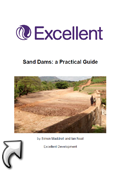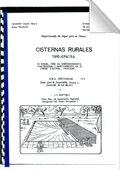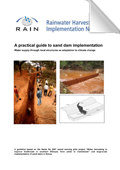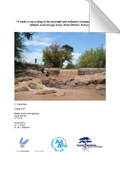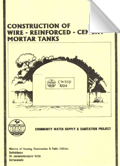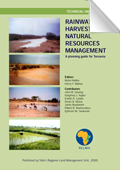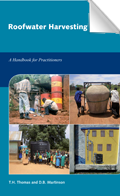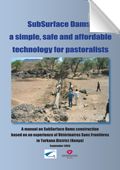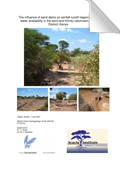
Filter by category
Or search
Loading search form...
Explanation
SamSamWater makes information on water and sanitation easy to find and accessible for all. This page contains a database with practical information, data and (GIS)maps.
We believe information should be shared to make water and sanitation projects more successful. The information in the database is gathered from numerous sources, such as research institutes, companies, NGOs and government organisations.
Do you have information we can integrate into this database, or if you have comments or questions, please contact us!
33 items found within the categories:
Rainwater harvesting
Clear search filter.
Simon Maddrell and Ian Neal, Excellent Development (2012)
Erik Nissen-Petersen, ASAL Consultants Ltd. (2011)
A.W.A. Oosterbaan & J.V. Martinez, Departemento de Ague para el Chaco (1987)
RAIN Foundation, RAIN Foundation ()
Cedrick Gijsbertsen, VU (2007)
Merel Hoogmoed, VU (2007)
Neil Herath, Comminity Water Supply & Sanitation Project (CWSSP), Ministry of Housing, Construction & Public Utilities, Sri Lanka (1995)
Lucas Borst, Sander de Haas, VU (2006)
Kithinji Mutunga, Will Critchley, Sida's Regional Land Management Unit (2002)
ERHA, RAIN Foundation, ()
RAIN Foundation, RAIN Foundation (2008)
Janette Worm, Tim van Hattum, Agromisa (2006)
Nuhu Hatibu, Henry F. Mahoo, Sida's Regional Land Management Unit (2000)
Th.M. Boers, ILRI (1994)
T.H. Thomas, D.B. Martinson, IRC (2007)
Jo Smet, Christine van Wijk, IRC (2002)
NWP, NWP (2007)
VSF-Belgium, VSF-Belgium (2006)
WaterAid, WaterAid (2007)
Jasper Jansen, VU (2007)
Erik Nissen-Petersen, DANIDA (2006)
Erik Nissen-Petersen, DANIDA (2006)
Erik Nissen-Petersen, DANIDA (2006)
Erik Nissen-Petersen, DANIDA (2006)
Erik Nissen-Petersen, Sida's Regional Land Management Unit (2000)
Erik Nissen-Petersen, WEDC Conference (1997)
Erik Nissen-Petersen, DANIDA (2006)
Rainwater harvesting
Clear search filter.
Sand Dams: a Practical Guide
Simon Maddrell and Ian Neal, Excellent Development (2012)
This manual describes the process of siting, design, construction and management of sand dams. It is aimed at technical and programme management staff working in arid and semi-arid lands who are interested in trialling the application of sand dams in new areas. The manual draws upon the experience of constructing sand dams in Kenya, where the majority of the world’s sand dams are located. Its primary purpose is to capture this experience. (source)
Subsurface dams built of soil
Erik Nissen-Petersen, ASAL Consultants Ltd. (2011)
Paper on subsurface dams, their benefits and practical experiences with the planning, design and construction of subsurface dams. (source)
Serie:
Water for Arid Lands (all items in this serie)
Categories:
Technology and techniques
Rainwater harvesting
Groundwater hydrology
Water for Arid Lands (all items in this serie)
Categories:
Technology and techniques
Rainwater harvesting
Groundwater hydrology
Cisternas rurales
A.W.A. Oosterbaan & J.V. Martinez, Departemento de Ague para el Chaco (1987)
Un manual para su dimensionamiento construction, y mantenimiento en el chaco central, Paraguay. (source)
A practical guide to sand dam implementation
RAIN Foundation, RAIN Foundation ()
Water supply through local structures as adaptation to climage change (source)
A study to upscaling of the principle and sediment transport processes behind sand storage dams, Kitui District, Kenya
Cedrick Gijsbertsen, VU (2007)
A study on the upscaling of the sand storage dam and the sedimentation processes that occur in the surroudings of the sand storage dam. (source)
Serie:
Sanddam.org Sand storage dams reports (all items in this serie)
Categories:
Rainwater harvesting
Infiltration and artificial recharge
Groundwater hydrology
Sanddam.org Sand storage dams reports (all items in this serie)
Categories:
Rainwater harvesting
Infiltration and artificial recharge
Groundwater hydrology
Akvopedia from Akvo.org
Wikipedia-like knowledgebase on water and sanitation. Contains many useful smart and affordable technical solutions and effective approaches.
Analyses of impacts of a sand storage dam on gw flow and storage
Merel Hoogmoed, VU (2007)
(source)
Serie:
Sanddam.org Sand storage dams reports (all items in this serie)
Categories:
Rainwater harvesting
Infiltration and artificial recharge
Groundwater hydrology
Sanddam.org Sand storage dams reports (all items in this serie)
Categories:
Rainwater harvesting
Infiltration and artificial recharge
Groundwater hydrology
Appropedia
Wikipedia-like knowledgebase on collaborative solutions in sustainability, poverty reduction and international development. Including sections on Water and Health.
Construction of wire-reinforced cement mortar tanks
Neil Herath, Comminity Water Supply & Sanitation Project (CWSSP), Ministry of Housing, Construction & Public Utilities, Sri Lanka (1995)
this document has been scanned from earlier manuals and standardizations prepared by Neil Herath for CWSSP – Sri Lanka ( April 1995), and as Manual 3 of the Technical Manual Series on Rural Water Supply and Sanitation, Gravity Water Supply Systems: design and construction (January 2005). It is redesigned to look like the 2005 CWSSP manual guiding field work on wirereinforced cement mortar tanks, commonly known as ferrocement tanks (Han Heijnen, October 2010) (source)
Hydrology of Sand Storage Dams - A case study in the Kiindu catchment, Kitui District, Kenya
Lucas Borst, Sander de Haas, VU (2006)
This report reflects the results of a research project concerning the hydrology around sand storage dams. The Kitui district is one of the arid and semi-arid lands of Kenya. For (drinking)water most people heavily rely on water supply from the riverbeds of ephemeral rivers. SASOL is a local NGO which builds so called sand storage dams in ephemeral rivers to increase the water availability during the dry season. Sand storage dams are small (generally a few meters high) dams built in the riverbed behind which sand accumulates, enlarging the natural aquifer. The groundwater in the riverbed is obstructed by the dam and retained between the pores in the sand, making it available for people and animals during the dry season. (source)
Serie:
Sanddam.org Sand storage dams reports (all items in this serie)
Categories:
Rainwater harvesting
Infiltration and artificial recharge
Groundwater hydrology
Sanddam.org Sand storage dams reports (all items in this serie)
Categories:
Rainwater harvesting
Infiltration and artificial recharge
Groundwater hydrology
Low-cost methods of rainwater storage; Results from field trials in Ethiopia and Kenya
Kithinji Mutunga, Will Critchley, Sida's Regional Land Management Unit (2002)
Rainwater harvesting is one solution to the problems of water shortage in the drier areas of Africa, but its implementation presents a number of challenges, of which storage is the main one. Many people in rural areas who would like to harvest rainwater lack the resources to do so. Conventional stone, brick or ferrocement tanks are costly, and therefore there is a great need for cheaper alternatives. This publication gives an account of two trials conducted in 1998/99 to investigate some such alternatives. In Ethiopia, five different methods of tank construction were tested in the suburbs of Nazareth town in Adama Woreda. In Kenya, six different methods were tested during the same period at various locations in Machakos and Makueni Districts. A main feature of the alternative tank designs is that they are built underground, which reduces the need for reinforcement materials. (source)
Serie:
RELMA Technical Handbook Series No. 28 (all items in this serie)
Categories:
Technology and techniques
Rainwater harvesting
Roofwater harvesting
RELMA Technical Handbook Series No. 28 (all items in this serie)
Categories:
Technology and techniques
Rainwater harvesting
Roofwater harvesting
Manual on Sand Dams in Ethiopia
ERHA, RAIN Foundation, ()
A practical approach on sand dam site selection, design and construction. A tool for combining sand dams with other rainwater harvesting structures. (source)
RAIN Water Quality Guidelines; Guidelines and practical tools on rainwater quality
RAIN Foundation, RAIN Foundation (2008)
This document addresses RAINs guidelines towards water quality and gives criteria and practical guidelines to improve and maintain an acceptable water quality of harvested rainwater for drinking purpose. (source)
Rainwater harvesting for domestic use
Janette Worm, Tim van Hattum, Agromisa (2006)
Book Agrodok 43: 'Rainwater harvesting for domestic use' with useful and practical applications of rainwater harvesting in developing countries. (source)
Rainwater harvesting for natural resources management; A planning guide for Tanzania
Nuhu Hatibu, Henry F. Mahoo, Sida's Regional Land Management Unit (2000)
A planning handbook that provides planners with practical tips on how rainwater harvesting can form an integrated part of district development efforts. The book also gives practical guidelines in the planning steps required to incorporate rainwater harvesting in development plans, and shows how to implement them in the farmers’ context. (source)
Serie:
RELMA Technical Handbook Series No. 22 (all items in this serie)
Categories:
Technology and techniques
Rainwater harvesting
Roofwater harvesting
Infiltration and artificial recharge
RELMA Technical Handbook Series No. 22 (all items in this serie)
Categories:
Technology and techniques
Rainwater harvesting
Roofwater harvesting
Infiltration and artificial recharge
Rainwater Harvesting in Arid and Semi-Arid Zones
Th.M. Boers, ILRI (1994)
The publication describes a procedure for the design of micro-catchments in sem-arid areas. (source)
Serie:
ILRI Publication 55 (all items in this serie)
Categories:
Rainwater harvesting
Roofwater harvesting
ILRI Publication 55 (all items in this serie)
Categories:
Rainwater harvesting
Roofwater harvesting
Roofwater Harvesting; A Handbook for Practitioners
T.H. Thomas, D.B. Martinson, IRC (2007)
A handbook with guidelines for implementing (low cost) domestic roofwater harvesting systems or programmes. (source)
Serie:
Technical Paper Series 49 (all items in this serie)
Categories:
Technology and techniques
Rainwater harvesting
Roofwater harvesting
Technical Paper Series 49 (all items in this serie)
Categories:
Technology and techniques
Rainwater harvesting
Roofwater harvesting
SamSamWater Climate Tool (precipitation & evaporation)
Local climate data is very important for water studies. However, climate data is not always available or accessible. The SamSamWater Climate Tool uses data from 28800 stations of FAOCLIM to estimate precipitation and evaporation anywhere on Earth.
SandDam.org
All you need to know about sand storage dams.
Small Community Water Supplies: Rain water harvesting (chapter 7)
Jo Smet, Christine van Wijk, IRC (2002)
(source)
Serie:
Small Community Water Supplies: Technology, people and partnership (all items in this serie)
Categories:
Technology and techniques
Rainwater harvesting
Small Community Water Supplies: Technology, people and partnership (all items in this serie)
Categories:
Technology and techniques
Rainwater harvesting
Smart Water Harvesting Solutions
NWP, NWP (2007)
This booklet on Smart Water Harvesting describes a number of creative solutions in situations where ‘there seems to be no water’. It shows practical efforts to ‘create water’, especially in drought prone areas. It does not limit itself to the act of harvesting, but includes ‘capturing’ water during periods of rain, so that it is available for periods of drought. Many of the technologies highlighted in this booklet are traditional, but neglected in the modern world, as people try to become less dependent on the wiles of nature. There is an increasing awareness that rather than fighting against nature, people should co-operate with it. That is what water harvesting tries to do.
Like its equivalents on Smart Water and Smart Sanitation, this book gives examples that have proven to be effective and affordable. The book is an effective source of inspiration for local communities, civil engineers, NGOs, research institutes, donors and governments. (source)
Serie:
Smart water solutions (all items in this serie)
Categories:
Technology and techniques
Rainwater harvesting
Roofwater harvesting
Infiltration and artificial recharge
Smart water solutions (all items in this serie)
Categories:
Technology and techniques
Rainwater harvesting
Roofwater harvesting
Infiltration and artificial recharge
SubSurface Dams: a simple, safe and affordable technology for pastoralists
VSF-Belgium, VSF-Belgium (2006)
A manual on SubSurface Dams construction
based on an experience of Vétérinaires Sans Frontières
in Turkana District (Kenya) (source)
Technology notes
WaterAid, WaterAid (2007)
These technology notes have been prepared following many general enquiries for technical information having been received by WaterAid over the years.
Their purpose is to give an outline of the technologies used by WaterAid on long-term development projects in Africa and Asia, and to show alternatives which might be appropriate in different circumstances.
It may be possible to determine from the notes the technology which would be appropriate in a particular location.
If it is proposed to proceed with the design and construction of a project using any of the principles set out in these notes, it is strongly recommended that further details be obtained from a specialist or from the reference books which are listed at the end of the relevant section. (source)
The influence of sand dams on rainfall-runoff response and water availability
Jasper Jansen, VU (2007)
(source)
Serie:
Sanddam.org Sand storage dams reports (all items in this serie)
Categories:
Rainwater harvesting
Infiltration and artificial recharge
Surface water hydrology
Groundwater hydrology
Sanddam.org Sand storage dams reports (all items in this serie)
Categories:
Rainwater harvesting
Infiltration and artificial recharge
Surface water hydrology
Groundwater hydrology
The Water Channel
TheWaterChannel is an online video channel completely dedicated to water related videos.
Tutorial: Using free online data to determine catchment boundaries
This tutorial explains the possibilities of freely available worldwide elevation maps. Data from these maps can be used in hydrological projects, for example to determine catchment boundaries.
Water from Dry Riverbeds
Erik Nissen-Petersen, DANIDA (2006)
How dry and sandy riverbeds can be turned into water sources by hand-dug wells, subsurface dams, weirs and sand dams (source)
Serie:
Water for Arid Lands Book 3 (all items in this serie)
Categories:
Technology and techniques
Rainwater harvesting
Infiltration and artificial recharge
Water for Arid Lands Book 3 (all items in this serie)
Categories:
Technology and techniques
Rainwater harvesting
Infiltration and artificial recharge
Water from roads
Erik Nissen-Petersen, DANIDA (2006)
A handbook for technicians and farmers on harvesting rainwater from roads (source)
Serie:
Water for Arid Lands Book 6 (all items in this serie)
Categories:
Technology and techniques
Rainwater harvesting
Infiltration and artificial recharge
Water for Arid Lands Book 6 (all items in this serie)
Categories:
Technology and techniques
Rainwater harvesting
Infiltration and artificial recharge
Water from Rock Outcrops
Erik Nissen-Petersen, DANIDA (2006)
A handbook for engineers and technicians on site investigations, designs, construction and maintenance of rock catchment tanks and dams (source)
Serie:
Water for Arid Lands Book 1 (all items in this serie)
Categories:
Technology and techniques
Rainwater harvesting
Infiltration and artificial recharge
Water for Arid Lands Book 1 (all items in this serie)
Categories:
Technology and techniques
Rainwater harvesting
Infiltration and artificial recharge
Water from roofs
Erik Nissen-Petersen, DANIDA (2006)
A handbook for technicians and builders on survey, design, construction and maintenance of roof catchments (source)
Serie:
Water for Arid Lands Book 7 (all items in this serie)
Categories:
Technology and techniques
Rainwater harvesting
Roofwater harvesting
Water for Arid Lands Book 7 (all items in this serie)
Categories:
Technology and techniques
Rainwater harvesting
Roofwater harvesting
Water from sand rivers; A manual on site survey, design, construction and maintenance of seven types of water structures in riverbeds
Erik Nissen-Petersen, Sida's Regional Land Management Unit (2000)
Sand rivers, also called dry riverbeds, transport rainwater run-off from highlands to the sea through the most dry parts of this planet where water is very scarce. Although flood water may be drawn from the sand in some riverbeds for a short period of time after floods, the big majority of sand rivers are dry throughout the years. This book explains in simple terms how dry riverbeds can be changed into water sources for long periods after floods - and in some cases throughout the years. The usual problems of contamination and evaporation in hot climates are almost eliminated due the water being trapped and stored underground between the sand particles of riverbeds. This book is based on the author’s practical experience on developing affordable water supply systems in some of the driest parts of Africa and Asia over the last 25 years. (source)
Serie:
RELMA Technical Handbook Series No. 23 (all items in this serie)
Categories:
Rainwater harvesting
Infiltration and artificial recharge
RELMA Technical Handbook Series No. 23 (all items in this serie)
Categories:
Rainwater harvesting
Infiltration and artificial recharge
Water from sand-rivers
Erik Nissen-Petersen, WEDC Conference (1997)
A manual with guidelines for extraction of water out of (dry) sand rivers. (source)
Water from Small Dams
Erik Nissen-Petersen, DANIDA (2006)
A handbook for technicians, farmers and others on site investigations, designs, cost estimates, construction and maintenance of small earth dams (source)
Serie:
Water for Arid Lands Book 4 (all items in this serie)
Categories:
Technology and techniques
Rainwater harvesting
Infiltration and artificial recharge
Water for Arid Lands Book 4 (all items in this serie)
Categories:
Technology and techniques
Rainwater harvesting
Infiltration and artificial recharge

